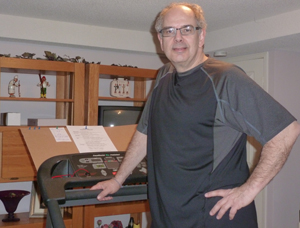Mark Lemieux was 54 years old when a 90% obstruction was detected requiring artery stents.
Mark had exercised intermittently throughout adulthood, but when kids came along in his thirties his activity level decreased noticeably and he slowly gained weight. After his heart procedure, his physician recommended cardiac rehab.
 As a full-time marketing professional, living out in Markham, the cardiac rehab program at Toronto Rehab's Rumsey Centre wouldn't fit his schedule.
As a full-time marketing professional, living out in Markham, the cardiac rehab program at Toronto Rehab's Rumsey Centre wouldn't fit his schedule.
"I would have gone to the hospital program for a week or two and then probably would have let it slide," explains Mark. "I couldn't have coordinated it with my day-to-day lifestyle."
Mark's dilemma highlights a troubling paradox with huge implications. Cardiac rehabilitation saves lives — yet almost 80% of heart patients don't do it. This has led to a new way of thinking about how to reach people who aren't participating in hospital-based cardiac rehab programs.
The basic idea: if people won't come to hospital, why not take the therapy to them?
Home-based cardiac programs, which allow patients to do the program at home with online and phone support, look to be a promising alternative to reach people who might not otherwise take part, according to a new study. Published in the April edition of the journal Applied Physiology, Nutrition and Metabolism, the study of one of Canada's largest home cardiac rehab programs shows that the approach is reaching a wider population of patients.
"Patients in Toronto Rehab's home cardiac rehab program were younger, lived further away from the hospital, and were more likely to be working, compared to patients in the hospital-based program," explains lead author Kerseri Scane, clinical coordinator in the Cardiovascular Prevention and Rehabilitation Program.
Importantly, patients who did the home program made the same gains in cardiovascular fitness and were just as likely to stick with the program as those who took part in the hospital's on-site cardiac rehab program, the study found. Scane and her colleagues compared 100 patients who participated in Toronto Rehab's home program to 100 on-site patients.
"These results show the home-based approach is a suitable option for people unable to participate in a traditional onsite program," says Scane. "The home program can help address barriers to doing cardiac rehab, such as work commitments and proximity to hospital."
In Mark's case, at the end of the six months of working out at home, logging his diet and monitoring his blood pressure, he had lost more than 30 pounds and his cardiovascular fitness had improved by 80%.
The benefits of cardiac rehab are well proven. A 2009 study by scientists at the Institute for Clinical Evaluative Sciences and Toronto Rehab found that people who participate in cardiac rehab after experiencing a major heart event cut the risk of dying from another one in half.
Scane expects the study will encourage more hospitals to offer home programs, which are less costly per patient than on-site ones. She hopes the study will raise awareness among family physicians that there are alternate models for cardiac rehab that may better suit some of their patients.
Participants in Toronto Rehab's home program, launched in 2007, undergo a fitness assessment at the hospital and are given an individualized exercise plan. They work out from home, e-mailing exercise logs to a case manager who follows up with weekly prescheduled phone calls. Patients also learn about nutrition, psychosocial and other heart-related issues using a workbook and videotaped Internet lectures. Patients live as far away as northern Ontario, and sometimes beyond.
In future studies, Scane wants to examine why some patients complete their home rehabilitation and others do not. Researchers at Toronto Rehab are also studying why women are underrepresented in cardiac rehab programs. Indeed, Scane's study shows home program participants were more likely to be men.
